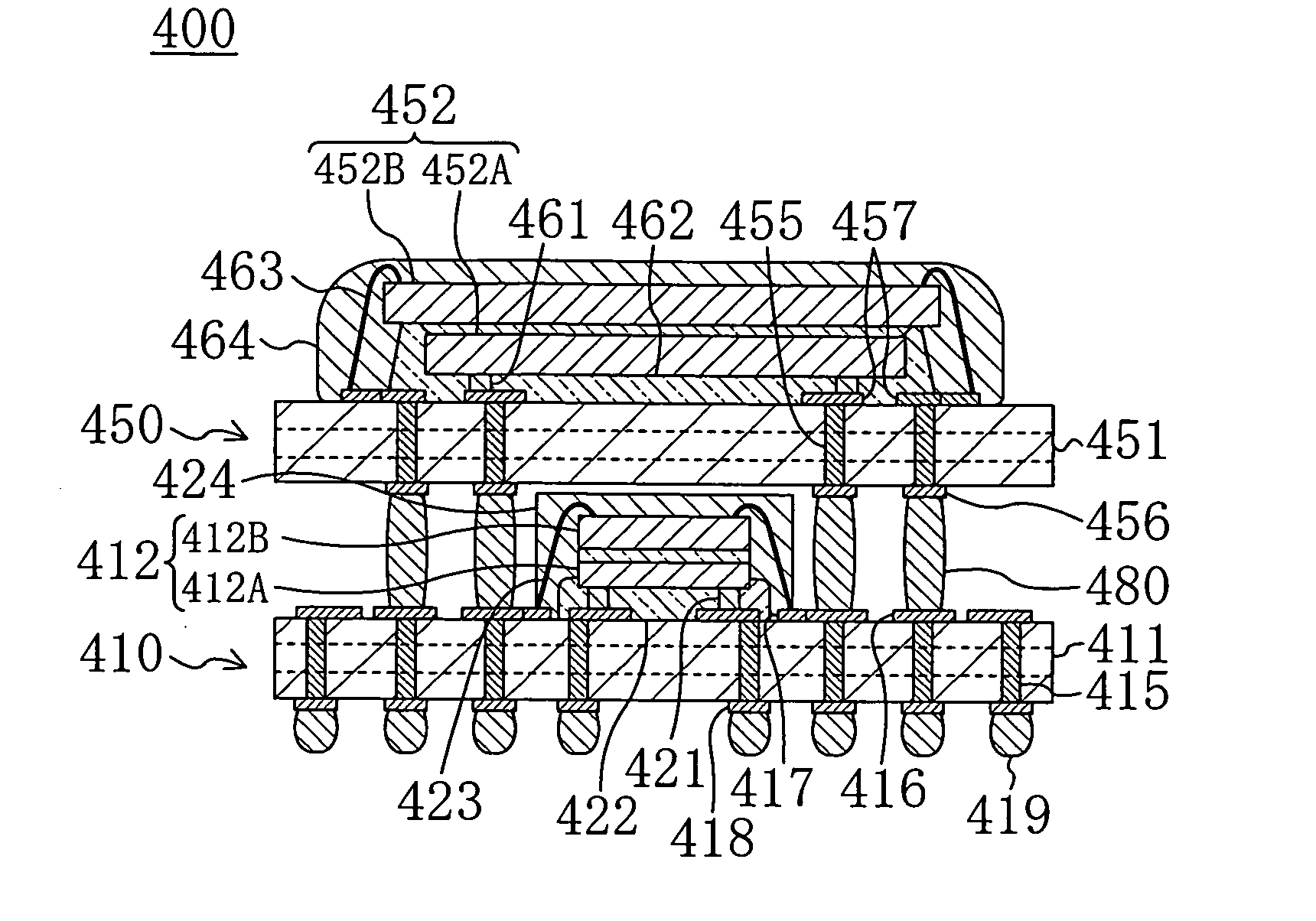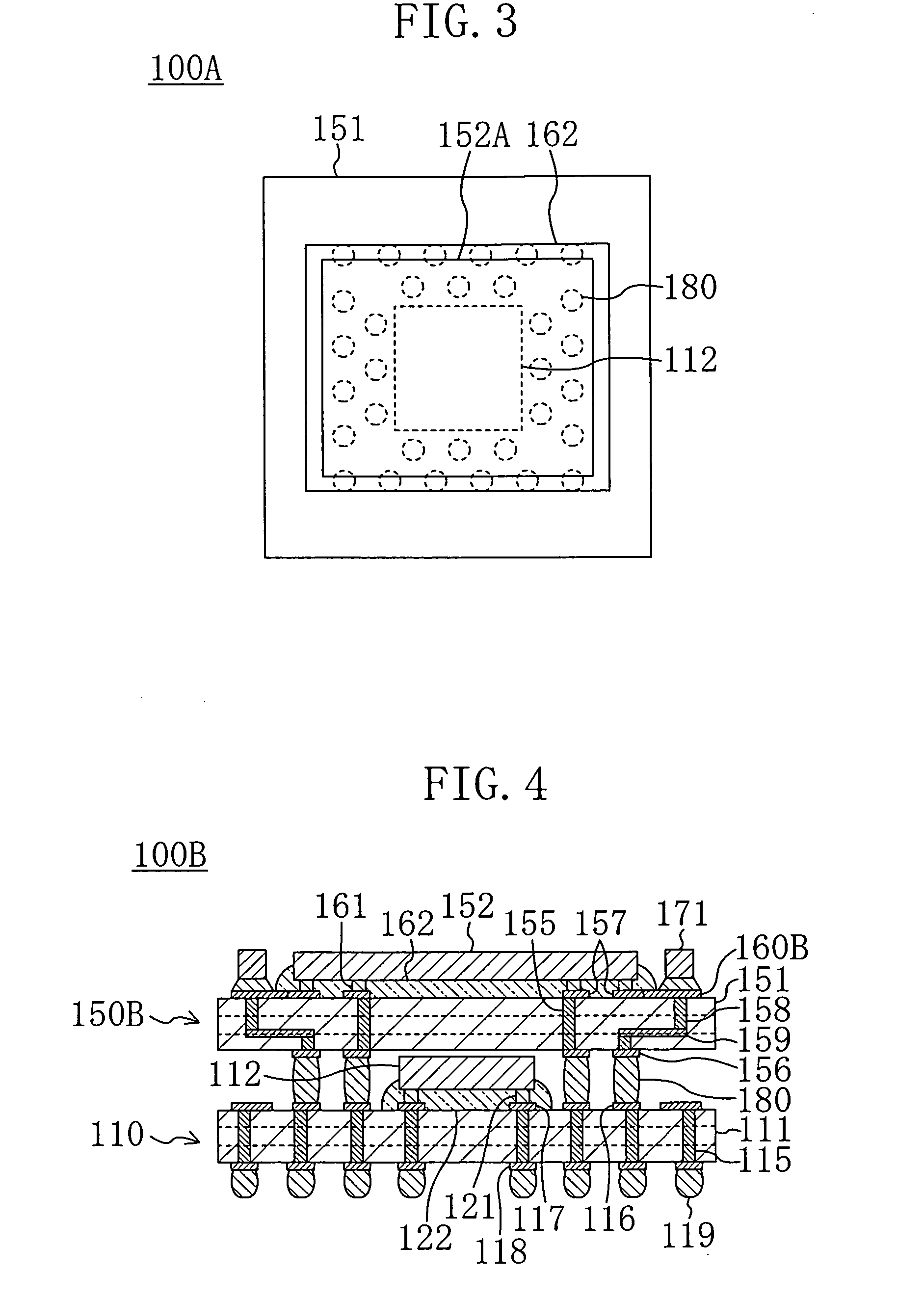Stacked semiconductor module
a technology of stacked semiconductor modules and semiconductor devices, which is applied in the direction of semiconductor devices, semiconductor/solid-state device details, electrical apparatus, etc., can solve the problems of affecting the reliability of connection between stacked semiconductor devices, difficult to mount chips of different types, and uneven arrangement of solder ball bumps on a wide area, so as to reduce the influence of thermal stress, the effect of the same thermal expansion coefficient and high reliability
- Summary
- Abstract
- Description
- Claims
- Application Information
AI Technical Summary
Benefits of technology
Problems solved by technology
Method used
Image
Examples
first embodiment
[0044]FIG. 1 shows a cross-sectional structure of a stacked semiconductor module 100 according to a first embodiment of the present invention, and FIG. 2 shows a plan structure of the stacked semiconductor module 100.
[0045] The stacked semiconductor module 100 is designed so that a second semiconductor device 150 with a second semiconductor chip 152 mounted to the top surface of a second semiconductor substrate 151 is stacked above a first semiconductor device 110 with a first semiconductor chip 112 mounted to a first semiconductor substrate 111.
[0046] In the first semiconductor substrate 111 having a multilayer interconnection structure, the center portion of the top surface thereof is provided with a region where the first semiconductor chip 112 is disposed. The inside of the first semiconductor substrate 111 is provided with a plurality of through conductors 115 extending from the top surface to the bottom surface. The top surface of the first semiconductor substrate 111 is pro...
second embodiment
[0070]FIG. 5 shows a cross-sectional structure of a stacked semiconductor module 200 according to a second embodiment of the present invention, and FIG. 6 shows a plan structure of the stacked semiconductor module 200.
[0071] The stacked semiconductor module 200 is designed so that a second semiconductor device 250 with a second semiconductor chip 252 mounted to the top surface of a second semiconductor substrate 251 is stacked above a first semiconductor device 210 with a first semiconductor chip 212 mounted to a first semiconductor substrate 211. The second embodiment is characterized in that the second semiconductor chip 252 is composed of a plurality of semiconductor chips disposed on the same plane.
[0072] In the first semiconductor substrate 211 having a multilayer interconnection structure, the center portion of the top surface thereof is provided with a region where the first semiconductor chip 212 is disposed. The inside of the first semiconductor substrate 211 is provided ...
third embodiment
[0087]FIG. 8 shows a cross-sectional structure of a stacked semiconductor module 300 according to a third embodiment of the present invention.
[0088] The stacked semiconductor module 300 is designed so that a second semiconductor device 350 with a second semiconductor chip 352 mounted to the top surface of a second semiconductor substrate 351 is stacked above a first semiconductor device 310 with a first semiconductor chip 312 mounted to the bottom surface of a first semiconductor substrate 311. The third embodiment is characterized in that the first semiconductor chip 312 is disposed below the bottom surface of the first semiconductor substrate 311.
[0089] In the first semiconductor substrate 311 having a multilayer interconnection structure, the center portion of the bottom surface thereof is provided with a region where the first semiconductor chip 312 is disposed. The inside of the first semiconductor substrate 311 is provided with a plurality of through conductors 315 extending...
PUM
 Login to View More
Login to View More Abstract
Description
Claims
Application Information
 Login to View More
Login to View More - R&D
- Intellectual Property
- Life Sciences
- Materials
- Tech Scout
- Unparalleled Data Quality
- Higher Quality Content
- 60% Fewer Hallucinations
Browse by: Latest US Patents, China's latest patents, Technical Efficacy Thesaurus, Application Domain, Technology Topic, Popular Technical Reports.
© 2025 PatSnap. All rights reserved.Legal|Privacy policy|Modern Slavery Act Transparency Statement|Sitemap|About US| Contact US: help@patsnap.com



